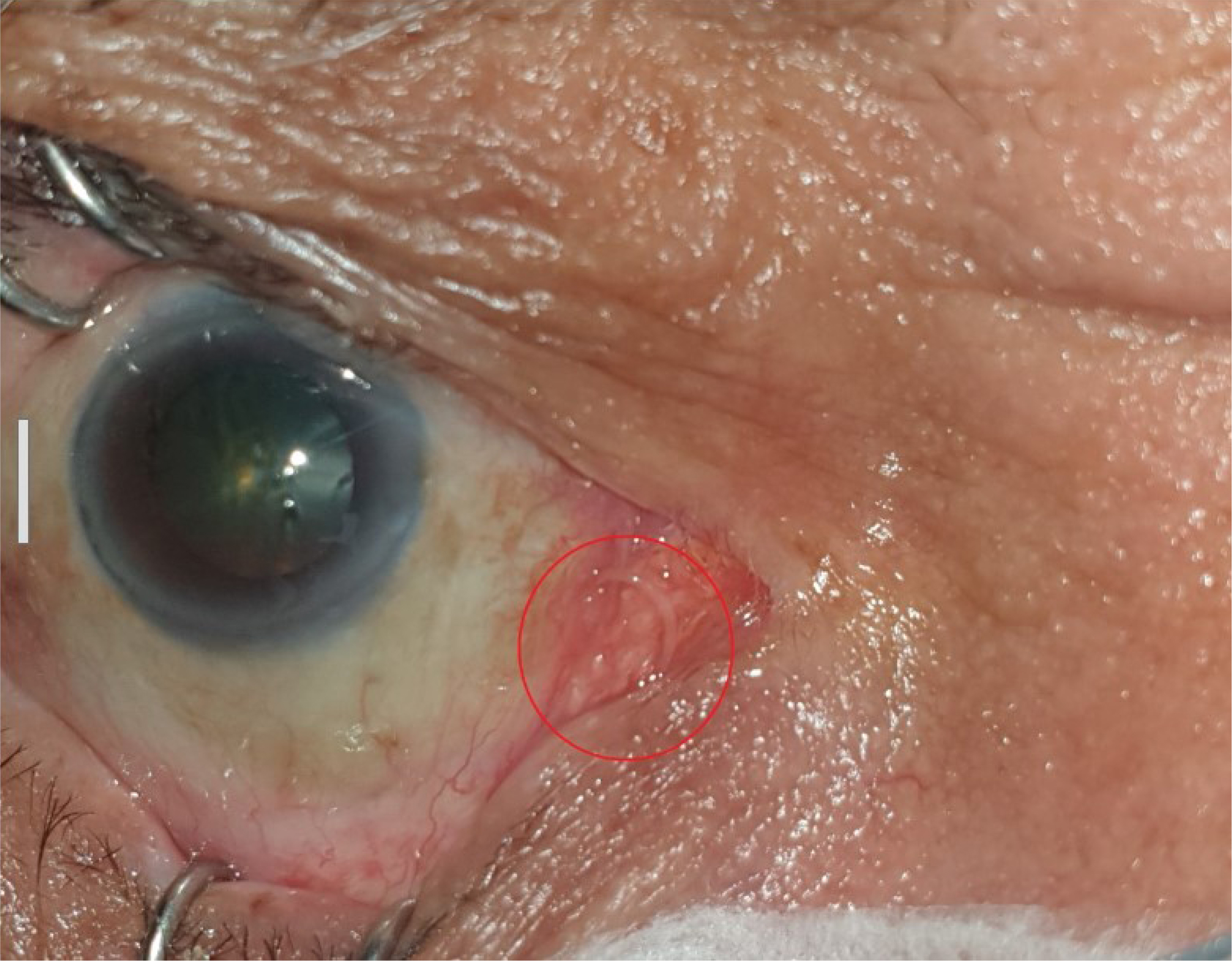Korean J healthc assoc Infect Control Prev.
2022 Jun;27(1):77-79. 10.14192/kjicp.2022.27.1.77.
A Case of Thelazia Callipaeda Ocular Infection Identified in Patients with Subarachnoid Haemorrhage
- Affiliations
-
- 1Division of Infectious Diseases, Department of Internal Medicine, Gil Medical Center, Gachon University College of Medicine, Incheon, Korea
- 2Department of Ophthalmology, Gil Medical Center, Gachon University College of Medicine, Incheon, Korea
- KMID: 2530830
- DOI: http://doi.org/10.14192/kjicp.2022.27.1.77
Abstract
- Therazia callipaeda is known to cause infections in animals and human eyes, such as dogs and cats, using fruit flies as vectors. Two white translucent thread-shaped parasites were found in the right eye of an 84-year-old man hospitalised in the intensive care unit because of a traumatic cerebral haemorrhage. Parasites were removed, the conjunctiva was washed with physiological saline, and the removed parasites were diagnosed as T. callipaeda. An ophthalmic examination was performed 1 month after parasite removal, and no additional parasites or abnormal findings in the eyes were confirmed. Considering the life cycle of Thelazia, prevention of ocular thelaziasis is to avoid environments that may be exposed to fruit flies and to keep the eyes clean from tears and sweat. Environmental management and inpatient hygiene should be given attention because infected parasites can survive in the host for a long time. In addition, careful observation of the internal and external conditions of the eye and appropriate examination are needed during the treatment of patients who are not conscious or have difficulty accurately presenting symptoms.
Keyword
Figure
Reference
-
1. Otranto D, Traversa D. 2005; Thelazia eyeworm: an original endo- and ecto-parasitic nematode. Trends Parasitol. 21:1–4. DOI: 10.1016/j.pt.2004.10.008. PMID: 15639731.2. Otranto D, Dutto M. 2008; Human thelaziasis, Europe. Emerg Infect Dis. 14:647–9. DOI: 10.3201/eid1404.071205. PMID: 18394285. PMCID: PMC2570937.
Article3. Otranto D, Lia RP, Buono V, Traversa D, Giangaspero A. 2004; Biology of Thelazia callipaeda (Spirurida, Thelaziidae) eyeworms in naturally infected definitive hosts. Parasitology. 129(Pt 5):627–33. DOI: 10.1017/S0031182004006018. PMID: 15552407.
Article4. Dolff S, Kehrmann J, Eisermann P, Dalbah S, Tappe D, Rating P. 2020; Case report: Thelazia callipaeda eye infection: the first human case in Germany. Am J Trop Med Hyg. 102:350–1. DOI: 10.4269/ajtmh.19-0483. PMID: 31912777. PMCID: PMC7008349.5. Choi YJ, Shin GR, Kim YD. 2016; A case of subconjunctival Thelasia callipaeda infestation. J Korean Ophthalmol Soc. 57:1476–9. DOI: 10.3341/jkos.2016.57.9.1476.
Article6. Lee DH, Park SH, Yu HS, Lee JE. 2018; A case of Thelazia callipaeda infestation with preseptal cellulitis. J Korean Ophthalmol Soc. 59:181–4. DOI: 10.3341/jkos.2018.59.2.181.
Article7. Otranto D, Cantacessi C, Testini G, Lia RP. 2006; Phortica variegata as an intermediate host of Thelazia callipaeda under natural conditions: evidence for pathogen transmission by a male arthropod vector. Int J Parasitol. 36:1167–73. DOI: 10.1016/j.ijpara.2006.06.006. PMID: 16842795.
Article8. Centers for Disease Control. Laboratory identification of parasites of public health concern. Thelaziasis. https://www.cdc.gov/dpdx/thelaziasis/index.html. (Updated on 2 July 2019).9. Otranto D, Mendoza-Roldan JA, Dantas-Torres F. 2021; Thelazia callipaeda. Trends Parasitol. 37:263–4. DOI: 10.1016/j.pt.2020.04.013. PMID: 32451294.
Article10. Choi WY, Youn JH, Nam HW, Kim WS, Kim WK, Park SY, et al. 1989; Scanning electron microscopic observations of Thelazia callipaeda from human. Kisaengchunghak Chapchi. 27:217–23. DOI: 10.3347/kjp.1989.27.3.217. PMID: 2486933.
Article11. do Vale B, Lopes AP, da Conceição Fontes M, Silvestre M, Cardoso L, Coelho AC. 2019; Thelaziosis due to Thelazia callipaeda in Europe in the 21st century-a review. Vet Parasitol. 275:108957. DOI: 10.1016/j.vetpar.2019.108957. PMID: 31630050.
Article12. Lee SM, Shin KM, Kim DH, Kang BN. 2010; A case of Thelazia callipaeda recurred at a one-month interval. J Korean Ophthalmol Soc. 51:895–8. DOI: 10.3341/jkos.2010.51.6.895.
Article13. Gu BH, Oh DE. 2018; A case of twice recurring ocular thelaziasis from Thelazia callipaeda. J Korean Ophthalmol Soc. 59:867–70. DOI: 10.3341/jkos.2018.59.9.867.
Article14. Yim CH, Ko JH, Lee JH, Choi YM, Lee WW, Ahn SK, et al. 2016; A pediatric case of thelaziasis in Korea. Korean J Parasitol. 54:319–21. DOI: 10.3347/kjp.2016.54.3.319. PMID: 27417087. PMCID: PMC4977780.
Article
- Full Text Links
- Actions
-
Cited
- CITED
-
- Close
- Share
- Similar articles
-
- A Case of Twice Recurring Ocular Thelaziasis from Thelazia callipaeda
- A human case of Thelazia callipaeda infection with reference to its internal structures
- A Case of Thelazia Callipaeda Recurred At a One-month Interval
- A Case of Thelazia callipaeda Infestation with Preseptal Cellulitis
- A Case of Subconjunctival Thelasia Callipaeda Infestation



